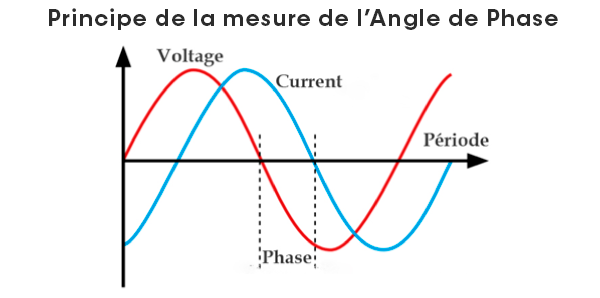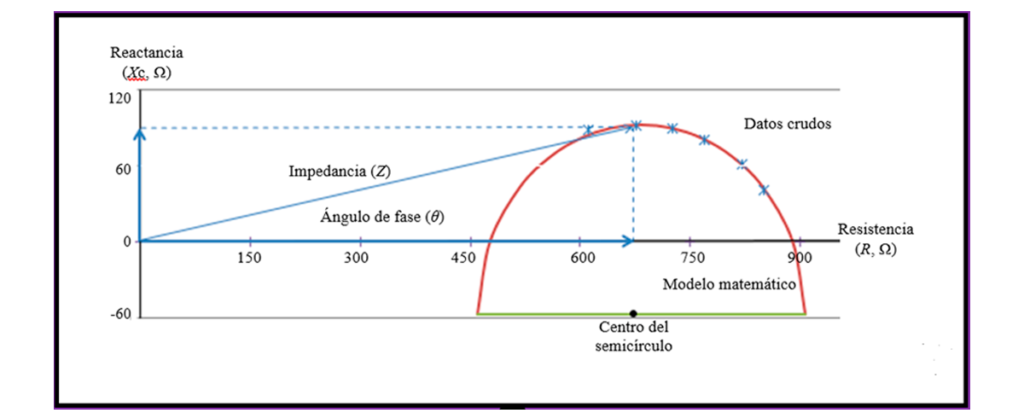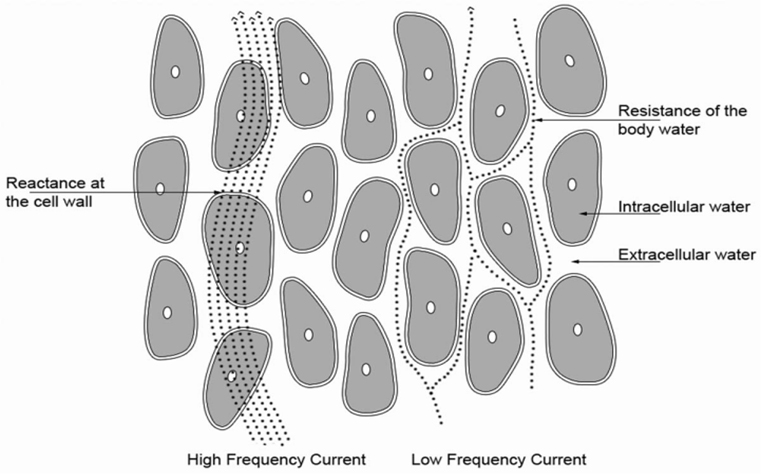In addition to body composition, bioimpedance analysis provides raw bioelectric values, including phase angle and impedance ratio, which are very useful in the day-to-day practice of healthcare professionals.
Phase angle (PhA)
The phase angle (PhA) is a raw bioelectric value measured by bioimpedance analysis devices in two ways:
- directly as the difference between the voltage and the current curves (Fig. 1A).
- from the resistance (R) and reactance (Xc) by the calculation: arctan
 (Fig 1B).
(Fig 1B).
A

B

- The PhA value is lower in women than in men, which can be explained by their lower cell mass, but this does not mean that they are in poorer health.
- Athletes who have built up a significant skeletal muscle mass will have higher PhA values than untrained individuals of the same sex.
- From the age of 60, PhA begins to decline progressively with cell ageing.
- Chronic degenerative diseases (8–10)
- overweight and obesity (11,12)
- chronic kidney disease (13)
- liver cirrhosis (14) as well as other liver diseases (15)
- cancer (16–18)
- systemic sclerosis (19)
- malnutrition (20,21)
- sarcopenia (22,23)
- rheumatoid arthritis (24)
- frailty in elders (25,26)
- ICU patients (27)
- as a screening tool for nutritional management in hospitals (28)
- anorexia nervosa (29)
- AIDS (30)
- Covid-19 (31)
- In children (32)
- In patients undergoing surgery (33)
Biody XpertZM and Biody XpertZMII
Men
| IMC 18,5-25 | Lower limit | Vulnerability state | Normal values |
|---|---|---|---|
| 18-29 ans | 6,05 | 6,05 – 6,86 | 6,86 – 8,30 |
| 30-59 ans | 5,73 | 5,37 – 6,63 | 6,63 – 8,03 |
| ≥ 60 ans | 4,30 | 4,30 – 5,53 | 5,53 – 7,17 |
| IMC 25-30 | Lower limit | Vulnerability state | Normal values |
|---|---|---|---|
| 18-29 ans | 6,32 | 6,32 – 7,08 | 7,08 – 8,48 |
| 30-59 ans | 5,94 | 5,94 – 6,92 | 6,92 – 8,30 |
| ≥ 60 ans | 4,77 | 4,77 – 5,86 | 5,86 – 7,36 |
| IMC >30 | Lower limit | Vulnerability state | Normal values |
|---|---|---|---|
| 18-29 ans | 6,07 | 6,07 – 7,01 | 7,01 – 8,43 |
| 30-59 ans | 6,19 | 6,19 – 6,91 | 6,91 – 8,35 |
| ≥ 60 ans | 4,82 | 4,82 – 5,87 | 5,87 – 7,39 |
Women
| IMC 18,5-25 | Lower limit | Vulnerability state | Normal values |
|---|---|---|---|
| 18-29 ans | 4,73 | 4,73 – 5,80 | 5,80 – 7,16 |
| 30-59 ans | 5,14 | 5,14 – 5,96 | 5,96 – 7,30 |
| ≥ 60 ans | 4,23 | 4,23 – 5,28 | 5,28 – 6,84 |
| IMC 25-30 | Lower limit | Vulnerability state | Normal values |
|---|---|---|---|
| 18-29 ans | 5,33 | 5,33 – 6,03 | 6,03 – 7,39 |
| 30-59 ans | 5,29 | 5,29 – 6,12 | 6,12 – 7,46 |
| ≥ 60 ans | 4,47 | 4,47 – 5,43 | 5,43 – 6,87 |
| IMC >30 | Lower limit | Vulnerability state | Normal values |
|---|---|---|---|
| 18-29 ans | 5,41 | 5,41 – 6,12 | 6,12 – 7,48 |
| 30-59 ans | 5,45 | 5,45 – 6,21 | 6,21 – 7,55 |
| ≥ 60 ans | 4,51 | 4,51 – 5,45 | 5,45 – 6,91 |
Impedance ratio
The impedance ratio is defined as the ratio of the impedance measured at 200 kHz (Z200) to the one measured at 5 kHz (Z5). These frequencies were chosen because of the particular characteristics of the cell membrane. Currents with frequencies below 7 kHz are not capable of crossing the cell membrane and therefore of penetrating the intracellular space, so these currents are only sensitive to the composition of the extracellular compartment. On the opposite, at 200 kHz, the current is able to cross the cell membrane and will therefore be sensitive to the composition of the body as a whole.

Figure 2 : Diagram showing current propagation as a function of frequency within the cell space (Extracted from Moonen et al. 2021, DOI: 10.1097/MCC.0000000000000840)
This specificity means that the impedance ratio is sensitive to the distribution of water between the intra- and extracellular compartment, particularly in situation like inflammation. Inflammation is associated with a degradation of the cell membrane, resulting in a transfer of intracellular water to the interstitial space, which will modify the impedance at 200 and 5 kHz. More precisely, as the cell is less hydrated, the impedance at 200 kHz will increase, whereas as the extracellular space is more hydrated, the impedance at 5 kHz will decrease. Mathematically, the impedance ratio will therefore be higher when the individual is in an inflammatory state, which has been verified by the positive correlation between this parameter and CRP, a biomarker of inflammation. (39).
There are currently no published reference values for this parameter in the scientific literature, but empirically it seems that above 0.80 for men and 0.82 for women, there is a low-grade inflammatory state in the individual. If the inflammatory state worsens, the impedance ratio will increase, while conversely, if the inflammation subsides, the impedance ratio will decrease. Generally, the normal values are:
- Between 0.75 and 0.80 in men, but lower values can be found in sporty individuals.
- Between 0.77 and 0.82 in women, but lower values can also be observed in sportswomen.
Interestingly, there is a significant inverse relationship between phase angle and impedance ratio, so when an individual is in good health, their phase angle will be high and their impedance ratio low. On the opposite, when an individual’s health status deteriorates, the value of the phase angle will decrease and that of the impedance ratio will increase, generally caused by an increase in oxidative stress and inflammation. Conversely, when the patient’s health status improves, the phase angle and impedance ratio will return to their normal values. They are therefore two parameters of interest for monitoring an individual’s health status.
Conclusion
Phase angle and impedance ratio are two raw bioimpedancemetry values linked to membrane integrity and inflammatory state, respectively. Their main benefit is therefore that they can be used to monitor the general health status of individuals quickly, economically, and non-invasively, both for prevention or management of chronic pathologies and for athletes during training.
References
- Bellido D, García-García C, Talluri A, Lukaski HC, García-Almeida JM. Future lines of research on phase angle: Strengths and limitations. Rev Endocr Metab Disord. 12 avr 2023;1‑21.
- Mattiello R, Amaral MA, Mundstock E, Ziegelmann PK. Reference values for the phase angle of the electrical bioimpedance: Systematic review and meta-analysis involving more than 250,000 subjects. Clinical Nutrition. 1 mai 2020;39(5):1411‑7.
- Xiong ZH, Zheng XM, Zhang GY, Wu MJ, Qu Y. The Use of Bioelectrical Impedance Analysis Measures for Predicting Clinical Outcomes in Critically Ill Children. Frontiers in Nutrition [Internet]. 2022 [cité 16 janv 2024];9. Disponible sur: https://www.frontiersin.org/articles/10.3389/fnut.2022.847480
- Uribe G, Ortiz J, Jaramillo M. Ángulo de Fase (AF) e Índice de impedancia (IR) por BIA multifrecuencia: biomarcadores del estado nutricional de población adulta sana. Universidad Libre de Pereira. 2022;en prensa.
- Ramírez-Herrera CJ, Pico-Tarazona JC, Sánchez IA, Garavito-Peña FR, Mendoza-Romero D, Castro-Jiménez LE. Ángulo de fase como indicador de riesgo cardiovascular en estudiantes universitarios. Revista Colombiana de Cardiología [Internet]. 2021 [cité 16 janv 2024];28(6). Disponible sur: https://www.rccardiologia.com/frame_esp.php?id=122
- de Borba EL, Ceolin J, Ziegelmann PK, Bodanese LC, Gonçalves MR, Cañon-Montañez W, et al. Phase angle of bioimpedance at 50 kHz is associated with cardiovascular diseases: systematic review and meta-analysis. Eur J Clin Nutr. 12 avr 2022;
- Langer RD, Larsen SC, Ward LC, Heitmann BL. Phase angle measured by bioelectrical impedance analysis and the risk of cardiovascular disease among adult Danes. Nutrition. 1 sept 2021;89:111280.
- Caccialanza R, Cereda E, Klersy C, Milani P, Cappello S, Martinelli V, et al. Bioelectrical impedance vector analysis-derived phase angle predicts survival in patients with systemic immunoglobulin light-chain amyloidosis. Amyloid. 2 juill 2020;27(3):168‑73.
- Mosquera-Hurtado DA, Rivera-Zuluaga V, Uribe-Gil G. USOS DEL ANGULO DE FASE EN ALGUNAS ENFERMEDADES CRONICO DEGENERATIVAS. Revista cultura del cuidado. 2022;en prensa.
- Lima e Silva RR de, Pinho CPS, Galvão Rodrigues I, Monteiro Júnior JG de M. Ángulo de fase como indicador del estado nutricional y pronóstico en pacientes críticos. Nutrición Hospitalaria. mars 2015;31(3):1278‑85.
- Curvello-Silva K, Ramos LB, Sousa C, Daltro C. Phase angle and metabolic parameters in severely obese patients. Nutr Hosp. 16 déc 2020;37(6):1130‑4.
- de Luis DA, Aller R, Romero E, Dueñas A, Perez Castrillon JL. Relation of phase angle tertiles with blood adipocytokines levels, insulin resistance and cardiovascular risk factors in obese women patients. Eur Rev Med Pharmacol Sci. juin 2010;14(6):521‑6.
- Topete-Reyes JF, López-Lozano CA, López-Báez SL, Barbarín-Vázquez AV, Cervantes-Villalobos ML, Navarro-Rodríguez J, et al. Determinación del estado nutricional mediante el ángulo de fase en pacientes en hemodiálisis. Gaceta Médica de México [Internet]. 2019 [cité 16 janv 2024];155(3). Disponible sur: https://www.gacetamedicademexico.com/frame_esp.php?id=299
- Selberg O, Selberg D. Norms and correlates of bioimpedance phase angle in healthy human subjects, hospitalized patients, and patients with liver cirrhosis. Eur J Appl Physiol. 1 avr 2002;86(6):509‑16.
- Peres W a. F, Lento DF, Baluz K, Ramalho A. Phase angle as a nutritional evaluation tool in all stages of chronic liver disease. Nutr Hosp. 2012;27(6):2072‑8.
- Gupta D, Lammersfeld CA, Vashi PG, King J, Dahlk SL, Grutsch JF, et al. Bioelectrical impedance phase angle as a prognostic indicator in breast cancer. BMC Cancer. 27 août 2008;8(1):249.
- Gupta D, Lis CG, Dahlk SL, King J, Vashi PG, Grutsch JF, et al. The relationship between bioelectrical impedance phase angle and subjective global assessment in advanced colorectal cancer. Nutrition Journal. 30 juin 2008;7(1):19.
- Gupta D, Lis CG, Dahlk SL, Vashi PG, Grutsch JF, Lammersfeld CA. Bioelectrical impedance phase angle as a prognostic indicator in advanced pancreatic cancer. Br J Nutr. déc 2004;92(6):957‑62.
- Krause L, Becker MO, Brueckner CS, Bellinghausen CJ, Becker C, Schneider U, et al. Nutritional status as marker for disease activity and severity predicting mortality in patients with systemic sclerosis. Ann Rheum Dis. nov 2010;69(11):1951‑7.
- Lukaski HC, Kyle UG, Kondrup J. Assessment of adult malnutrition and prognosis with bioelectrical impedance analysis: phase angle and impedance ratio. Curr Opin Clin Nutr Metab Care. sept 2017;20(5):330‑9.
- Plank L, Li A. PP166-SUN BIOIMPEDANCE ILLNESS MARKER COMPARED TO PHASE ANGLE AS A PREDICTOR OF MALNUTRITION IN HOSPITALISED PATIENTS. Clinical Nutrition. 1 sept 2013;32:S85.
- Di Vincenzo O, Marra M, Di Gregorio A, Pasanisi F, Scalfi L. Bioelectrical impedance analysis (BIA) -derived phase angle in sarcopenia: A systematic review. Clin Nutr. mai 2021;40(5):3052‑61.
- Do JY, Kim AY, Kang SH. Association Between Phase Angle and Sarcopenia in Patients Undergoing Peritoneal Dialysis. Front Nutr. 2021;8:742081.
- Matsumoto Y, Tada M, Yamada Y, Mandai K, Hidaka N, Koike T. The bioimpedance phase angle is more useful than sarcopenia as a predictor of falls in patients with rheumatoid arthritis: Results from a 2-y prospective cohort study. Nutrition. 1 oct 2022;102:111729.
- Kuchnia A, Earthman C, Teigen L, Cole A, Mourtzakis M, Paris M, et al. Evaluation of Bioelectrical Impedance Analysis in Critically Ill Patients: Results of a Multicenter Prospective Study. JPEN J Parenter Enteral Nutr. sept 2017;41(7):1131‑8.
- Uemura K, Doi T, Tsutsumimoto K, Nakakubo S, Kim MJ, Kurita S, et al. Predictivity of bioimpedance phase angle for incident disability in older adults. Journal of Cachexia, Sarcopenia and Muscle. 2020;11(1):46‑54.
- Mulasi U, Vock DM, Kuchnia AJ, Jha G, Fujioka N, Rudrapatna V, et al. Malnutrition Identified by the Academy of Nutrition and Dietetics and American Society for Parenteral and Enteral Nutrition Consensus Criteria and Other Bedside Tools Is Highly Prevalent in a Sample of Individuals Undergoing Treatment for Head and Neck Cancer. JPEN J Parenter Enteral Nutr. janv 2018;42(1):139‑47.
- Cimmino F, Petrella L, Cavaliere G, Ambrosio K, Trinchese G, Monda V, et al. A Bioelectrical Impedance Analysis in Adult Subjects: The Relationship between Phase Angle and Body Cell Mass. Journal of Functional Morphology and Kinesiology. sept 2023;8(3):107.
- Marra M, De Filippo E, Signorini A, Silvestri E, Pasanisi F, Contaldo F, et al. Phase angle is a predictor of basal metabolic rate in female patients with anorexia nervosa. Physiol Meas. avr 2005;26(2):S145-152.
- Araujo Antunes A, Alves Pereira Rodrigues AP, Geraix J, Vaz de Arruda Silveira L, Câmara Marques Pereira P, Barros Leite Carvalhaes MA. Nutritional assessment of hospitalized HIV-infected patients by the phase angle z-score measurement. Nutr Hosp. 2012;27(3):771‑4.
- Cornejo-Pareja I, Vegas-Aguilar IM, Fernández-Jiménez R, García-García C, Bellido-Guerrero D, Tinahones F, et al. Phase angle and COVID-19: A systematic review with meta-analysis. Rev Endocr Metab Disord. 1 juin 2023;24(3):525‑42.
- Fernández-Jiménez R, Martín-Masot R, Cornejo-Pareja I, Vegas-Aguilar IM, Herrador-López M, Tinahones FJ, et al. Phase angle as a marker of outcome in hospitalized pediatric patients. A systematic review of the evidence (GRADE) with meta-analysis. Rev Endocr Metab Disord. 1 août 2023;24(4):751‑65.
- Siqueira Vassimon H, Jordao AA, Albuquerque de Paula FJ, Artioli Machado A, Pontes Monteiro J. Comparison of bioelectrical impedance with skinfold thickness and X-ray absorptiometry to measure body composition in HIV-infected with lipodistrophy. Nutr Hosp. 2011;26(3):458‑64.
- Yáñez-Sepúlveda R, Alvear-Ordenes I, Vargas-Silva J, Hernández-Jaña S, Olivares-Arancibia J, Tuesta M, et al. Characteristics of Body Composition, Phase Angle and Body Water in Elite Chilean Skydivers. International Journal of Morphology. déc 2021;39(6):1564‑9.
- Cirillo E, Pompeo A, Cirillo FT, Vilaça-Alves J, Costa P, Ramirez-Campillo R, et al. Relationship between Bioelectrical Impedance Phase Angle and Upper and Lower Limb Muscle Strength in Athletes from Several Sports: A Systematic Review with Meta-Analysis. Sports (Basel). 18 mai 2023;11(5):107.
- Langer RD, de Fatima Guimarães R, Gonçalves EM, Guerra-Junior G, de Moraes AM. Phase Angle is Determined by Body Composition and Cardiorespiratory Fitness in Adolescents. Int J Sports Med. août 2020;41(9):610‑5.
- Hetherington-Rauth M, Leu CG, Júdice PB, Correia IR, Magalhães JP, Sardinha LB. Whole body and regional phase angle as indicators of muscular performance in athletes. Eur J Sport Sci. déc 2021;21(12):1684‑92.
- Bosy-Westphal A, Danielzik S, Dörhöfer RP, Later W, Wiese S, Müller MJ. Phase Angle From Bioelectrical Impedance Analysis: Population Reference Values by Age, Sex, and Body Mass Index. Journal of Parenteral and Enteral Nutrition. 2006;30(4):309‑16.
- Demirci C, Aşcı G, Demirci MS, Özkahya M, Töz H, Duman S, et al. Impedance ratio: a novel marker and a powerful predictor of mortality in hemodialysis patients. Int Urol Nephrol. juill 2016;48(7):1155‑62.
